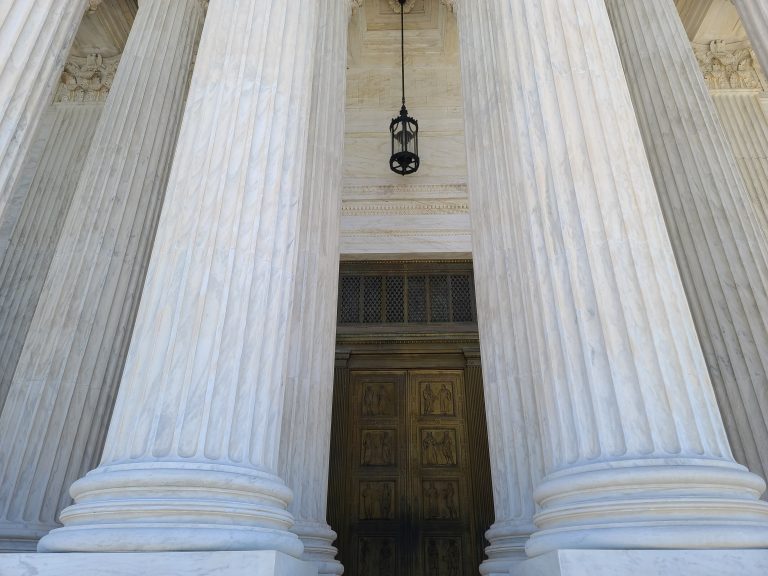The Supreme Court is set to take up its first Second Amendment case since its landmark ruling in New York State Rifle and Pistol Association v. Bruen. The outcome of the case will likely have a tremendous impact on the future of guns in America, and we now have new insight into the grounds on which it will be decided.
This week, the federal government filed its brief in United States v. Rahimi. The filing lays out the defense of the ban on those subject to a domestic violence restraining order possessing a gun after the Fifth Circuit found it unconstitutional. It represents the government’s answer to the critical question of who can be prohibited from owning a firearm under Bruen’s history and tradition test.
The brief is much more thorough than the one presented at the lower court. It addresses each aspect of the Fifth Circuit’s ruling, details historical laws and practices it argues supports the modern prohibition, and provides an overarching argument for why the domestic violence restraining order gun ban is constitutional.
That overarching argument is fairly straightforward.
“Although the Second Amendment guarantees an individual right to keep and bear arms, that right is not unlimited,” the government wrote. “As this Court recognized in District of Columbia v. Heller, and reiterated in NYSRPA v. Bruen, the Second Amendment allows Congress to disarm persons who are not law-abiding, responsible citizens.”
The brief goes in-depth on this point and repeatedly emphasizes that only “law-abiding, responsible citizens” are protected by the Second Amendment. It also switches between historical and practical arguments that are tailored to what the Court has previously held in its other gun cases.
Legal and Historical Arguments
The brief’s case for the domestic violence restraining order ban being a part of the American tradition of gun regulation rests mainly on the idea that legislatures have “disarmed individuals whom they have found to be dangerous, irresponsible, or otherwise unfit to possess arms” from before the Founding straight through the modern era.
“[D]uring the Revolutionary War, the Continental Congress recommended, and many States adopted, laws disarming loyalists. States in the 19th century disarmed minors, intoxicated persons, and vagrants,” the government wrote. “And Congress in the 20th century disarmed felons and persons with mental illnesses. Although different statutes disqualified different groups at different times, they reflect the same enduring principle: Legislatures may disarm those who are not law-abiding, responsible citizens. Section 922(g)(8) fits within that history and tradition because it disarms persons who are not law-abiding, responsible citizens.”
The government admitted there weren’t laws restricting those subject to restraining orders or domestic abusers in particular from owning guns before the 20th Century. However, it argued SCOTUS has “emphatically rejected demands for an exact historical match” and said the lack of domestic-violence-related gun prohibitions isn’t evidence the Founders believed they were impermissible.
“Past lawmakers’ failure to adopt a given regulation does not necessarily (or even ordinarily) reflect doubts about its constitutionality,” the government wrote. “The idea of adopting such a regulation may never have occurred to the lawmakers. They may have considered the regulation unnecessary, impractical, or politically inexpedient. Or they may have failed to act because of the ‘sluggishness of government, the multitude of matters that clamor for attention, and the relative ease with which men are persuaded to postpone troublesome decisions.'”
The government said the Court should take a more general view of historical analogies for the modern ban because attitudes towards domestic violence and firearms technology have changed significantly since the Founding.
“The absence of historical laws specifically targeting domestic abusers is especially unilluminating because it is readily explained by legal, social, and technological factors that have nothing to do with the Second Amendment,” the government wrote. “To start, past generations could not have disarmed persons subject to protective orders because such orders did not exist. For much of the Nation’s history, the common-law doctrine of interspousal tort immunity precluded courts from hearing abused wives’ civil suits against their husbands.”
It argued guns are more dangerous than they were during the Founding Era.
“Household homicides were rare in colonial times and only rarely committed with guns,” the government wrote. “But later technological developments—such as metallic cartridges; cheap, mass-produced revolvers; and guns capable of firing multiple shots—have led to the increased use of guns in homicides, including domestic homicides.”
“Now, more than half of the women who are killed by their intimate partners are killed with guns,” the brief said, citing a report from a gun-control group called the Violence Policy Center.
As for the difference between gun bans based on restraining orders and criminal convictions, the government argued Rahimi’s restraining order offered him the ability to contest accusations that he was dangerous and was only issued after a judge found he was dangerous based on multiple acts of violence he committed against the mother of his child. It also highlighted the myriad of other violent gun crimes he’s accused of committing as well as the elevated risk domestic abusers present to society generally. It further argued criminal convictions are not the only means legislatures have used to disarm people believed to be dangerous.
“[L]egal sources from the 17th, 18th, and 19th centuries recognize the government’s power to disarm irresponsible individuals regardless of their criminal records,” the brief said. “States have long disarmed groups other than criminals—for example, loyalists, minors, and intoxicated persons. And this Court has approved not only laws disarming ‘felons,’ but also laws disarming ‘the mentally ill.'”
It also rejected the idea that Rahimi can’t be disarmed because he is part of “the people.” The government argued that distinction doesn’t matter.
“[J]ust as Congress may ban dangerous and unusual weapons regardless of whether they qualify as ‘arms,’ so too it may disarm persons who are not law-abiding, responsible citizens regardless of whether they are among ‘the people,'” it wrote.
In the legal and historical arguments, the government emphasized Rahimi’s conviction is in line with the tradition of American gun restrictions–if you look at it from a certain point of view.
“Here, the government has identified many historical laws that impose the same type of burden as Section 922(g)(8) (disqualifying someone from possessing arms) for the same type of reason (the person is not responsible enough to be trusted with arms),” the brief said.
Practical Arguments
The government doesn’t just rely on generalized historical analogues to make its case, though. It also employs several pragmatic points.
For one, it argues that striking down the federal prohibition would be very disruptive because it isn’t an outlier like the gun restrictions previously tossed by the High Court.
“[A]t least 48 States and territories have adopted laws that disarm, or authorize courts to disarm, individuals who are subject to domestic-violence protective orders. That consensus confirms that the persons subject to Section 922(g)(8) are among those who can permissibly be disarmed because they cannot be trusted with firearms. It also distinguishes Section 922(g)(8) from the outlier laws found unconstitutional in Heller, Bruen, and McDonald v. City of Chicago.”
The government also turned to a linguistic argument about who can be barred from gun use. It said legislators, courts, and commentators have indicated throughout American history have approved of disarming dangerous individuals and groups.
“All in all, post-ratification sources point in the same direction as English and Founding Era sources,” the government wrote. “Although different commentators used different terms—’peaceable,’ ‘well-disposed,’ and so on—they recognized that a legislature could disarm those who were not law-abiding, responsible citizens.”
That includes SCOTUS itself, according to the brief.
“In Heller, this Court described the right to keep and bear arms as a ‘right of law-abiding, responsible citizens.'” the government wrote. “The Court also made clear that legislatures may adopt categorical prohibitions on the possession of arms by those who are not law-abiding and responsible, identifying ‘longstanding prohibitions on the possession of firearms by felons and the mentally ill’ as ‘examples’ of ‘presumptively lawful regulatory measures.'”
The government said that same trend was repeated in Bruen.
“In all, the Court’s opinion used the term ‘law-abiding, responsible citizens’ and its variants more than a dozen times to describe the Amendment’s scope,” it wrote.
The government also addressed the Fifth Circuit’s contention that its view of Second Amendment protections only extends to the “law-abiding” has no “limiting principle” and could end up disarming Americans for minor offenses like speeding or not recycling. It argued its standard only applies to those who are actually dangerous.
“[T]he ‘law-abiding, responsible citizens’ principle no more allows Congress to disarm anyone it pleases than the sensitive-places doctrine allows Congress to ban guns anywhere it pleases,” the government wrote. “Rather, this Court’s references to ‘law-abiding’ and ‘responsible’ citizens reflect the Second Amendment’s history and tradition and exclude only criminals and individuals whose possession of firearms would endanger themselves or others (such as underage individuals, persons with mental illnesses, drug users, and persons subject to protective orders). And it trivializes the profound harms of domestic violence to liken disarming domestic abusers to disarming ‘speeders’ or those ‘who do not recycle.'”
Instead, it noted the Fifth Circuit’s ruling has already inspired rulings against other federal gun prohibitions for drug users and violent felons who have already served their prison sentences. It warned SCOTUS that allowing the lower court’s ruling to stand would lead to more aspects of federal gun law being invalidated.
“Affirming the Fifth Circuit’s decision here could thus wreak havoc on other parts of Section 922(g), which ‘probably does more to combat gun violence than any other federal law,'” the brief said.
Ultimately, the government argued the Fifth Circuit approached the Bruen test in a way that was too narrow. It said the Supreme Court should take a broader view of American history when deciding Rahimi and all future gun cases.
“[T]he Fifth Circuit’s divide-and-conquer approach to the historical evidence was badly misguided,” it wrote. “A court applying the Second Amendment should not isolate each historical precursor and ask if it differs from the challenged regulation in some way. A court should instead examine the historical evidence as a whole, determine whether it establishes a category of permissible regulation (such as ‘dangerous and unusual weapons’ or ‘sensitive places’), and determine whether the challenged law fits in that category.”
The government concluded history and tradition support the idea that the “Second Amendment permits laws disarming persons who are not law-abiding, responsible citizens and Section 922(g)(8) plainly qualifies as such a law.”






